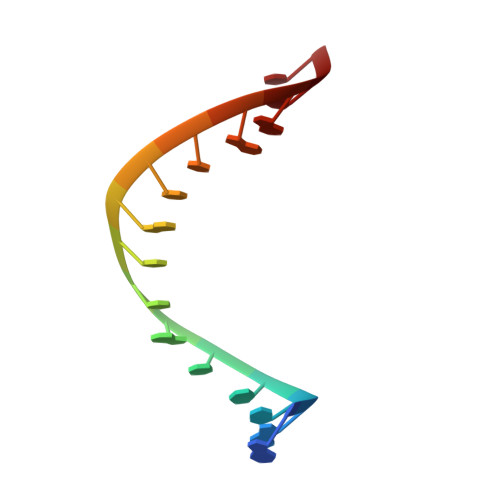Structure and Dynamics of RNA Repeat Expansions That Cause Huntington's Disease and Myotonic Dystrophy Type 1.
Chen, J.L., VanEtten, D.M., Fountain, M.A., Yildirim, I., Disney, M.D.(2017) Biochemistry 56: 3463-3474
- PubMed: 28617590
- DOI: https://doi.org/10.1021/acs.biochem.7b00252
- Primary Citation of Related Structures:
5VH7, 5VH8 - PubMed Abstract:
RNA repeat expansions cause a host of incurable, genetically defined diseases. The most common class of RNA repeats consists of trinucleotide repeats. These long, repeating transcripts fold into hairpins containing 1 × 1 internal loops that can mediate disease via a variety of mechanism(s) in which RNA is the central player. Two of these disorders are Huntington's disease and myotonic dystrophy type 1, which are caused by r(CAG) and r(CUG) repeats, respectively. We report the structures of two RNA constructs containing three copies of a r(CAG) [r(3×CAG)] or r(CUG) [r(3×CUG)] motif that were modeled with nuclear magnetic resonance spectroscopy and simulated annealing with restrained molecular dynamics. The 1 × 1 internal loops of r(3×CAG) are stabilized by one-hydrogen bond (cis Watson-Crick/Watson-Crick) AA pairs, while those of r(3×CUG) prefer one- or two-hydrogen bond (cis Watson-Crick/Watson-Crick) UU pairs. Assigned chemical shifts for the residues depended on the identity of neighbors or next nearest neighbors. Additional insights into the dynamics of these RNA constructs were gained by molecular dynamics simulations and a discrete path sampling method. Results indicate that the global structures of the RNA are A-form and that the loop regions are dynamic. The results will be useful for understanding the dynamic trajectory of these RNA repeats but also may aid in the development of therapeutics.
Organizational Affiliation:
Department of Chemistry, The Scripps Research Institute , Jupiter, Florida 33458, United States.














